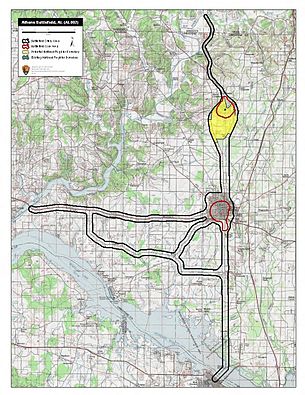The Battle of Sulphur Creek Trestle, also known as the Battle of Athens, was fought near Athens, Alabama (Limestone County, Alabama), from September 23 to 25, 1864 as part of the American Civil War.[5]
| Battle of Sulpher Creek Trestle | |||||||
|---|---|---|---|---|---|---|---|
| Part of the American Civil War | |||||||
| |||||||
| Belligerents | |||||||
|
|
| ||||||
| Commanders and leaders | |||||||
|
Wallace Campbell Jonas Elliott W. H. Lathrop George Spalding | Nathan Bedford Forrest | ||||||
| Units involved | |||||||
|
110th USCT 102nd Ohio Infantry 18th Michigan Infantry 111th USCT 4th Cavalry Division | Cavalry Corps, Department of Alabama, Mississippi, and East Louisiana | ||||||
| Strength | |||||||
| 2,350[1][2] | 4,500[3] | ||||||
| Casualties and losses | |||||||
| 2,350[1] | 139[4] | ||||||

In September 1864, General Nathan Bedford Forrest led his force into northern Alabama and middle Tennessee to disrupt the supply of William Tecumseh Sherman's army in Georgia.
The battle's site was listed on the National Register of Historic Places in 1973.[6]
Athens (September 23–24)
editOn the afternoon of 23 September, Union forces engaged Confederate forces five miles south of Athens, near Tanner, where they were destroying a railroad trestle. Forrest's Confederate forces moved towards Athens. That evening the Confederate forces gained control of the town, and the Union forces had retreated within Fort Henderson.
The Confederate forces began an artillery barrage on the morning of the 24th. In a personal meeting, Forrest convinced the Union commander, Colonel Wallace Campbell, that the Confederate forces numbered 8,000-10,000. Campbell surrendered the fort and its garrison around noon.
Shortly after the garrison had surrendered, reinforcements consisting of about 350 men from the 18th Michigan and 102nd Ohio, commanded by Jonas Elliott, arrived by train from Decatur. After suffering casualties of one-third their total personnel, these forces surrendered.
Sulphur Creek Trestle (September 25)
editAfter defeating the Union forces in Athens, Forrest moved north along the railroad with the intent to destroy a strategic trestle at Sulphur Creek, six miles north of Athens. A fortification, two blockhouses, and a force of 1,000 Union soldiers defended the trestle.
On the morning of the 25th, the Confederate forces began an artillery bombardment of the fort. The fortification had been built below the summits of adjacent hills, and thus provided little defense against the bombardment. 200 Union soldiers were killed, including the commander, Colonel William Hopkins Lathrop. By noon, George Spalding had surrendered the remaining 800 soldiers.[7] There were no reported Confederate losses.[4]
Aftermath
editThe Union prisoners were transferred to Confederate prisons. Many of these prisoners died on April 27, 1865, when the steamboat Sultana sank while transporting them home.
Notes
edit- ^ a b "Archived copy". Archived from the original on 2013-02-13. Retrieved 2013-02-19.
{{cite web}}: CS1 maint: archived copy as title (link) - ^ "Archived copy". Archived from the original on 2012-03-16. Retrieved 2013-02-19.
{{cite web}}: CS1 maint: archived copy as title (link) - ^ "Athens-Limestone County Civil Wat Trail" (PDF). tourathens.com. Archived from the original (PDF) on 2011-01-09. Retrieved 2013-02-19.
- ^ a b "The Official Records of the Civil War". eHistory at OSU.
- ^ The National Park service considers the engagements at Battle of Athens, September 23–24, and the Battle of Sulphur Creek Trestle, September 25 to be one battle Update to the Civil War Sites Advisory Commission Report on the Nation's Civil War Battlefields - State of Alabama.
- ^ "National Register Information System". National Register of Historic Places. National Park Service. July 9, 2010. Retrieved September 28, 2014.
- ^ Sulphur Battle
References
edit- [1] 20th (Russell's) Tennessee Cavalry, CSA
- Update to the Civil War Sites Advisory Commission Report on the Nation's Civil War Battlefields - State of Alabama
- [2]
- http://ehistory.osu.edu/osu/sources/recordView.cfm?Content=077/0514
- Limestone County Historical Society, Historical Marker Text for "Battle of Sulphur Creek Trestle". http://www.marker.limestonecountyhistoricalsociety.org/html/sulphur_battle.html. Erected 1982.
- Limestone County Historical Society. Historical Marker for "Fort Henderson", http://www.marker.limestonecountyhistoricalsociety.org/html/ft_henderson.html. Erected 2002.
- Greater Limestone County Chamber of Commerce, "Athens-Limestone County Civil War Trail: Self Guided Driving Tour Featuring the Battles of Athens & Sulphur Creek Trestle", [www.tourathens.com], February 2010. https://web.archive.org/web/20110109114558/http://tourathens.com/wp-content/uploads/2008/12/civil-war-trail-single-pages-Feb-20101.pdf